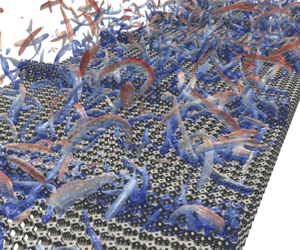No CrossRef data available.
Article contents
Direct numerical simulations of turbulent channel flow with a rib-roughened porous wall
Published online by Cambridge University Press: 08 February 2024
Abstract

To describe the effects of porous roughness on turbulence, we have carried out direct numerical simulations using the lattice Boltzmann method. The simulated flows are fully developed turbulent flows in channels consisting of a solid smooth top wall and a porous bottom wall with transverse porous ribs whose heights are 10 % of the channel height. The considered ratios of the rib spacing to the rib height are  $w/k\simeq 1$ and 9. The Kelvin-cell structure is applied to construct faithfully the porous media whose porosities are
$w/k\simeq 1$ and 9. The Kelvin-cell structure is applied to construct faithfully the porous media whose porosities are  $\varphi \ge 0.79$. Three kinds of porous media having different permeabilities are considered. The most permeable one has an approximately one order higher permeability than that of the least permeable one. The higher permeability case is designed to have a pore scale that is the same as the rib height so that it is the most permeable case for the rib roughness with the designed porosity. In the simulations, the bulk Reynolds number is set to
$\varphi \ge 0.79$. Three kinds of porous media having different permeabilities are considered. The most permeable one has an approximately one order higher permeability than that of the least permeable one. The higher permeability case is designed to have a pore scale that is the same as the rib height so that it is the most permeable case for the rib roughness with the designed porosity. In the simulations, the bulk Reynolds number is set to  $Re_b=5500$, and the corresponding permeability Reynolds numbers are
$Re_b=5500$, and the corresponding permeability Reynolds numbers are  $Re_K=2.2\unicode{x2013}7.5$. The simulated field data and the drag coefficient, which includes both the pressure drag by the ribs and the frictional drag over the porous wall, are analysed to understand the characteristics of the permeable roughness in terms of permeability. The decomposition of the drag coefficient into the integrated laminar, rib-drag, dispersion and turbulence parts elucidates the transition mechanism between the typical d-type to k-type roughness depending on
$Re_K=2.2\unicode{x2013}7.5$. The simulated field data and the drag coefficient, which includes both the pressure drag by the ribs and the frictional drag over the porous wall, are analysed to understand the characteristics of the permeable roughness in terms of permeability. The decomposition of the drag coefficient into the integrated laminar, rib-drag, dispersion and turbulence parts elucidates the transition mechanism between the typical d-type to k-type roughness depending on  $Re_K$. By the double (time and space) averaged budget equations for the dispersion and Reynolds stresses, we explain how the energy generated by the roughness transfers to turbulence through dispersion resulting in the k-type characteristics. The nominal roughness sublayer thickness and the characteristic roughness height are introduced with the parameters obtained by fitting the velocity data to Best's and Nikuradse's logarithmic velocity formulae. Along with data in the literature, it is suggested that the ratio of the characteristic roughness height to the nominal roughness sublayer thickness becomes constant irrespective of the rib spacing in the full permeable-wall turbulence at
$Re_K$. By the double (time and space) averaged budget equations for the dispersion and Reynolds stresses, we explain how the energy generated by the roughness transfers to turbulence through dispersion resulting in the k-type characteristics. The nominal roughness sublayer thickness and the characteristic roughness height are introduced with the parameters obtained by fitting the velocity data to Best's and Nikuradse's logarithmic velocity formulae. Along with data in the literature, it is suggested that the ratio of the characteristic roughness height to the nominal roughness sublayer thickness becomes constant irrespective of the rib spacing in the full permeable-wall turbulence at  $Re_K> 7$.
$Re_K> 7$.
- Type
- JFM Papers
- Information
- Copyright
- © The Author(s), 2024. Published by Cambridge University Press





